Click on images to enlarge
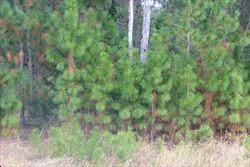
infestation in a eucalypt woodland (Photo: Sheldon Navie)
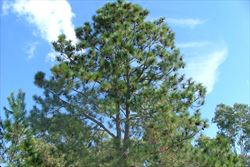
habit (Photo: Sheldon Navie)
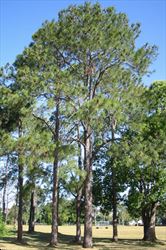
habit (Photo: Sheldon Navie)

bark on main trunk (Photo: Sheldon Navie)
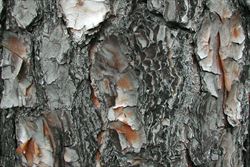
close-up of scaly bark (Photo: Sheldon Navie)
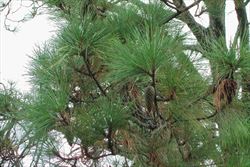
branches with leaves and female cones (Photo: Sheldon Navie)
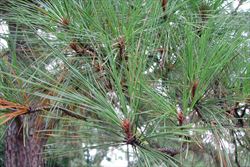
the long needle-like leaves (Photo: Sheldon Navie)

immature female cone (Photo: Sheldon Navie)
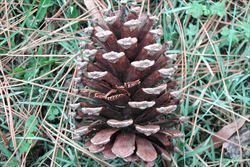
mature female cone (Photo: Sheldon Navie)

close-up of seeds (Photo: Steve Hurst at USDA PLANTS Database)

seedlings growing amongst old leaves and pieces of shed bark (Photo: Sheldon Navie)
Scientific Name
Pinus elliottii Engelm.
Synonyms
Pinus caribaea Morelet (misapplied)Pinus elliottii Engelm. var. densa Little & DormanPinus elliottii Engelm. var. elliottii
Family
Pinaceae
Common Names
American pitch pine, Florida pine, long-leaf pitch pine, pine, pine tree, plantation pine, slash pine, South Florida slash pine, swamp pine, yellow pine, yellow slash pine
Origin
Native to south-eastern USA (i.e. southern Alabama, Florida, southern Georgia, south-eastern Louisiana, southern Mississippi and South Carolina).
Cultivation
Slash pine (Pinus elliottii) is widely cultivated in Australia. It has been extensively planted in forestry plantations in sub-tropical regions for its good quality timber, and is also commonly grown as a garden ornamental and street tree.
Naturalised Distribution
This species is becoming widely naturalised in the sub-tropical regions of eastern Australia (i.e. widely naturalised in south-eastern Queensland and sparingly naturalised in the coastal districts of northern New South Wales).
Also naturalised in southern Africa (i.e. South Africa and Zimbabwe).
Habitat
A weed of roadsides, urban bushland, open woodlands, grasslands, disturbed sites and waste areas in sub-tropical regions.
Habit
A tall tree growing up to 30 m in height and up to 0.8 m across at the base. It has horizontal branches and usually sheds the lower ones as it grows, so the branches are usually quite high up on mature trees.
Distinguishing Features
- a large tree with grey to rusty brown bark that is shed in flat discs.
- its needle-like leaves (17.5-30 cm long) are grouped in twos or threes and held within a sheath at their base.
- its elongated male cones (2.5-6 cm long) are borne in clusters.
- its large female cones (7-20 cm long and 3-7 cm wide) are bonre on short stalks.
- these cones have small prickles on the tips each of their woody scales.
Stems and Leaves
The greyish-brown to reddish-brown coloured bark is shed in broad thin discs. Its younger branches are orange-brown in colour, while its shoots are bluish-green (i.e. glaucous).
The rigid needle-like leaves (17.5-30 cm long and 1.2-1.5 mm wide) are dark green in colour. They have a fine channel running lengthwise (i.e. longitudinally) and end in a pointed tip (i.e. acute apex). These leaves are grouped together in pairs or threes (i.e. fascicles) at the tips of the branches, and their bases are held within a light brown or greyish coloured sheath (1-2 cm long). When the leaves are shed, they fall in complete units along with their sheaths.
Flowers and Fruit
This species produces separate male and female reproductive cones (i.e. cones) on the same plant. The less obvious purplish-coloured male cones (2.5-6 cm long) are cylindrical and borne in clusters. The more prominent female cones (7-20 cm long and 3-7 cm wide) are borne on short stalks (up to 3 cm long) and are arranged singly or in pairs.
These cones mature over two or three years and are made up of many scales that have a tiny prickle (1-2 mm long) at their tips. The cones turn from green to brown or reddish-brown as they mature and split open when fully mature. Two seeds are borne on each of the scales. These seeds are egg-shaped (i.e. ovoid) or oval (i.e. ellipsoid) in shape with a papery wing (1.5-3 cm long) that is easily shed. The body of the seed is 6-7 mm long and mottled grey or black in colour.
Reproduction and Dispersal
This species reproduces by seed. The seeds are mostly spread short distances by wind. They are generally spread to new areas as a result of deliberate cultivation.
Environmental Impact
Slash pine (Pinus elliottii ) is regarded as an environmental weed in Queensland and New South Wales. It is also seen as a potential environmental weed in Western Australia.
Legislation
Not declared or considered noxious by any state government authorities.
Similar Species
Slash pine (Pinus elliottii) is similar to many other pine species that have become naturalised in Australia, including radiata pine (Pinus radiata), Caribbean pine (Pinus caribaea), cluster pine (Pinus pinaster) and Aleppo pine (Pinus halepensis). These species can be distinguished by the following differences:
- slash pine (Pinus elliottii) has relatively large symmetrical cones (7-20 cm long) that are borne on short stalks. Its leaves are relatively long (15-30 cm long) and borne in groups of two or three (usually in twos).
- radiata pine (Pinus radiata) has relatively large asymmetrical cones (7-17 cm long) that are borne on short curved stalks. Its leaves are relatively short (8-15 cm long) and usually borne in groups of three (rarely in twos).
- Caribbean pine (Pinus caribaea) has relatively small symmetrical cones (5-12 cm long) that are borne on short stalks. Its leaves are relatively long (15-30 cm long) and usually borne in groups of three (rarely in twos, fours or fives).
- cluster pine (Pinus pinaster) has relatively large slightly symmetrical or asymmetrical cones (9-20 cm long) that are almost stalkless (i.e. sessile). Its leaves are relatively long (10-30 cm long) and usually borne in groups of two.
- Aleppo pine (Pinus halepensis) has relatively small symmetrical cones (5-14 cm long) that are borne on curved stalks 10-30 mm long. Its leaves are relatively short (4-12 cm long) and usually borne in groups of two.

